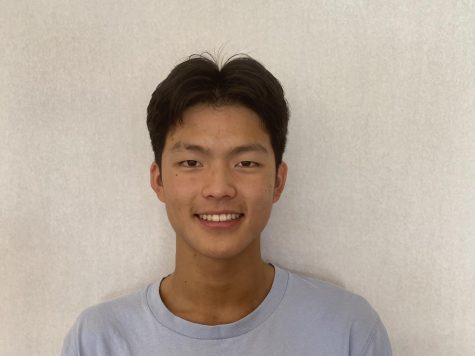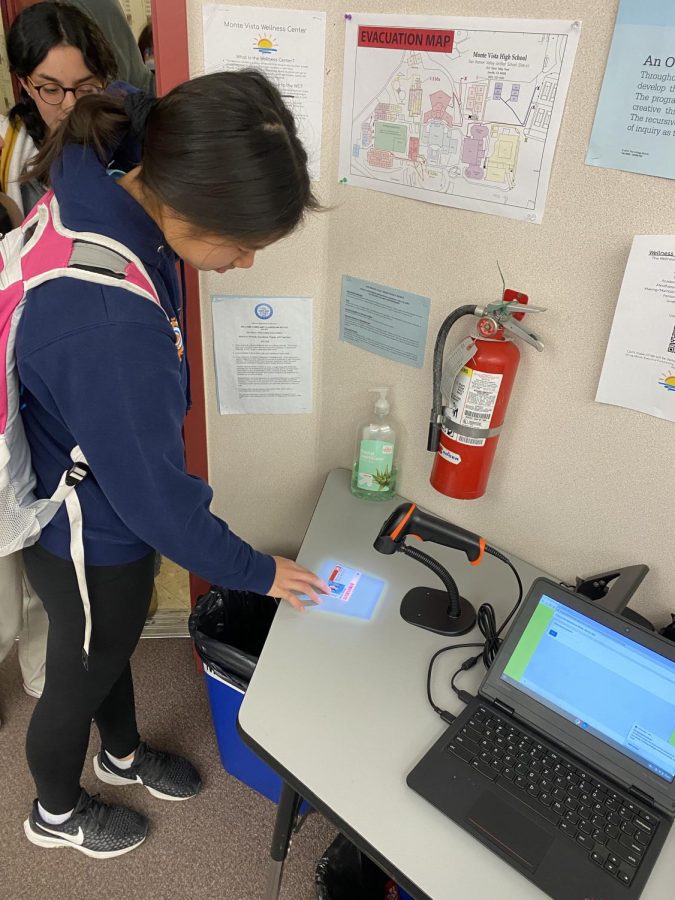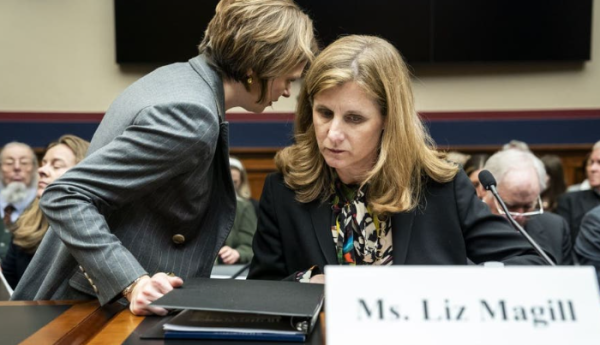The new green slip
Sophomore Grace Tseng scans into her class. The introduction of the new scanning system has led to an increase in detentions.
Students have found themselves receiving a new green slip. No, it’s not a visit to the counselor, but a visit to detention. This light green detention slip is part of a wave of new crackdowns on student attendance.
The 2022-2023 school year has introduced many new regulations that both students and staff are expected to follow. One of the most notable changes to student life on campus is the introduction of the scanning-in system.
The scanning-in system was implemented at Monte Vista as a new way to track student attendance. When students get into class they must scan their ID card or type in their student ID number. This new system is aimed at recording attendance more accurately, as teachers supposedly don’t need to manually check anymore. The system is programmed so that when a student scans into class after the bell and the five minute grace period, they are marked tardy. Additionally, if a student doesn’t scan in, they will receive a cut.
Due to the system generating more accurate information regarding student attendance
staff and administrators have noticed a spike in cuts and tardies.
“The automated attendance system has ‘equalized’ the potential for all students to be assigned a detention based on tardies and cuts, which means teachers and students who in the past may not have been officially recorded with tardies or cuts, now are,” said Monte Vista Assistant Principal Angie Corritone. “This naturally increased the number of detention notices that have gone out.”
As a result of this spike, more students have received detention for their attendance records. According to the Monte Vista detention policy, for every five tardies or three cuts a student will receive one hour of detention.
“When they reach that threshold, Infinite Campus sends an automated email, and that is followed up every two weeks with a green slip generated by the Attendance Office, as a reminder,” Corritone said. “It is cumulative, so it is possible for a student to collect additional hours if the behavior does not change.”
Historically, across the country, detention entailed extra work, chores, and campus cleanups for students breaking school rules. However, detention at Monte Vista is an hour-long study hall, where phones—but not school-issued Chromebooks—are confiscated.
But Monte Vista may be experiencing a different issue—less disciplinary detentions, but rather detentions resulting from a struggle to adjust to the new system of sign in to class. With the introduction of the late start time this school year, there has been a noticeable increase in traffic in the morning causing many students to be late to their first class of the day. If students scan into their class five minutes after the bell, they are marked in the system as tardy, which, according to many students, can add up very quickly.
Forgetting to scan into class is a problem many students are facing because when they get to class their first thought isn’t to scan in instead it is to get to their seat and pay attention to the teacher.
“Even a few months into school, it’s easy to forget to sign in,” sophomore Eric Chen said. “On top of that, I don’t get notified right away when I have an attendance issue, so it becomes hard to correct my attendance days later.”
After a student is marked tardy or absent, they have 48 hours to correct their attendance. This involves needing both the teacher and the attendance office to sign off a slip. Though not a difficult task, some students like Chen feel it is quite a hassle. Junior Sean Peart claimed he received detention for forgetting to scan in, but didn’t bother to correct his attendance.
“Having to correct the attendance was kind of a nuisance,” Peart said. “I didn’t really bother because [detention] was just an hour of my day and nothing more than a minor inconvenience.”
Peart also claimed that many of his friends also received detention for the same reason—forgetting to scan in and not correcting the attendance. Because detentions do not appear on transcripts, there is a sense of having little to lose.
But administrators argue that they want students to take accountability for their attendance and advocate for themselves if their attendance is wrong.
“If students have a legitimate circumstance that makes them tardy to class, we do have the ability to override the scanner,” Corritone said. “The human element is not completely lost but we are big fans of students learning to advocate for themselves.”
However, the heavy emphasis on attendance isn’t the only new crackdown on campus. This school year, there has been an increase of campus monitors all around Monte Vista, especially during Student Support and lunch.
Last school year, many students would use Student Support as a chance to leave school and go with their friends, instead of using it for its intended purpose of getting help from teachers and finishing up homework. Additionally, students would try to go to their car, during lunch to either eat lunch off campus or cut school with their friends.
With Monte Vista being a closed campus, students aren’t allowed to leave campus anytime during the school day, unless they are signed out by a legal parent or guardian.
While crackdowns on unauthorized students leaving campus are associated with liability concerns, it is also part of an effort to reduce truancies to help students succeed both academically and socially.
“The bottom line is that we know that attendance in general has a huge impact on success while in high school,” Corritone said.
Though the new scanning system has led to a dramatic rise in ‘accidental’ detentions, the school is still experiencing truancies just like any other school year. While the emphasis on the importance of being in class on time is a jaded topic among both students and administration, detentions continue to occur. But despite using detentions as a punitive measure, administration does not expect detention to single-handedly solve the root of the issue.
“Ultimately, the detention itself cannot change the behavior,” Corritone said. “That learning and responsibility falls upon the student.”

Maya Bhatt is a senior in her third year of Journalism, and she is thrilled to lead The Stampede as the...

Edi Zhang is a senior and will spend his fourth year on The Stampede as the Editor-in-Chief. He is honored...




